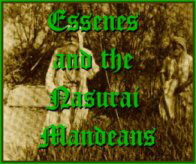
Essenes & Nasurai Mandaens

Essenes & Nasurai Mandaens
The Mandeaens are the surviving remnants of the Nasarene sect to which both Yeshua (Essene Jesus) and John the Baptist belonged. Many of their present practices and doctrines go back to the days when Yeshua (Jesus) walked the earth as one of their fellow Nasurai. They still refer to themselves, not as Mandeaens, which means Gnostic in their Aramaic language, but as Nasurai or Nasarenes. The word Nasurai comes from the Hebrew word nazar, i.e.. one separated or consecrated - hence monks and nuns. In ancient Israel the term was applied to those who were dedicated to Deity and who observe certain taboos such as no hair cutting, purity laws and a special diet.
The Mandeaens presently live on the river banks of the Euphrates and Tigris in Southern Iraq, in the marsh regions in Iran, and now in small diaspora communities in Australia and North America. They are said to number between 20 and 40 thousand.
The Mandeaens do not accept Yeshua (Jesus) as either the Messiah or a true prophet. They call Christians by the term "Kristiyane." This distinction can be traced back to at least 275 AD. The Karter inscription, found at Naqsh-i-Rustam, speaks of the Nasurai people as being officially distinct from the Kristiyane people. It is our understanding that this distinction goes all the way back to the days of John the Baptist and Yeshua.
Mandaean priests claim the west (i.e. Palestine) to be the original home of the sect, according to Widengren the Mandaeans do display many traits suggestive of Palestinian origin. Widengren and Foerster have shown that Mandaean presence can be traced back with certainty to early Christian or pre Christian times. Mandaean texts claim that the sect flourished under the Parthian Empire (250 BC - 191 AD). Reports regarding the existence of this sect were first brought to Europe by Portuguese monks - who labeled them as descendants from the disciples of John the Baptist - hence from that time on, in Church textbooks and writings they have been referred to as Christiani S. Ioannis i.e.. Christians of St. John. This is incorrect because the Mandaeans claim to have existed well before the Baptist, they also claim him as a teacher and not a prophet nor the originator of the sect.
We feel that the Nasurai Mandeaens are the descendants of those who wrongly rejected the message of Yeshua and who continued to follow the old Nasurai path, as exemplified by John the Baptist, rather than the New and Everlasting Covenant established by Yeshua.
The Mandaeans, themselves, hold the belief that both Yeshua (Jesus) and the Baptist were Nasurai, but that Yeshua (Jesus) was a rebel, who betrayed the secret Qabbalistic doctrines and made religion easier. John the Baptist, in contrast, is thought to be the truer teacher, skilled in magic and concerned with the healing of bodies and souls. This anti Jesus attitude is crystallized in their Book of John the Baptist.
Today, the term Nasurai is especially used by them for their priests. Another name referring to the Mandaeans is the Arabic term, Mughtasilla, amongst whom Mani, the founder of Manichaeism was born (216 AD). Mughtasilla means those who wash/purify themselves. (Along with the Jews and Christians the Mandaean "Sabians" have also been mentioned in the Koran on three occasions - as believers in One God and in the Last Judgment - from which the Sabians were [theoretically] assured of religious toleration.)
We accept the Nasurai claims that they are from the branch of the ancient Nasarene sect that rejected Yeshua's message and continued to follow John the Baptist and the older Nazarene Covenant. They have remained segregated and secluded since the coming of Islam and have kept relatively intact the heritage which they inherited from their ancestors. Because of this we feel that many of their preserved traditions and Mandaen Beliefs & Practices can give great insight into the more obscure teachings and practices of the early Nasarene followers of Yeshua.
This older Nazarene Covenant formed the foundation for both Yeshua and the New Covenant which he established. Deeper understanding of this New Nasarene Covenant can be gleaned from study of the older foundational Nazarene Covenant, as preserved by Mandaean oral and written traditions. These oral and written Nasurai traditions are perhaps a more true indicator of original Nasarene practices than are the Christian traditions which came, not solely from Yeshua and the early Nasarenes, but rather from them and other non-Nasurai cultures.
The Nazarenes of Mount Carmel
Copyright
© 1999-2016. The Nazarenes of Mount Carmel.
The Essene Numerology
Chart | Ministerial Training
Course